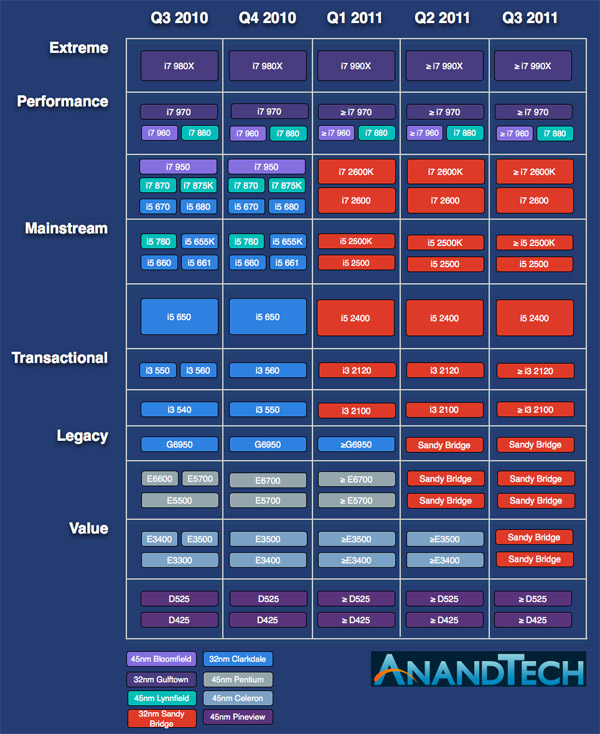The Sandy Bridge Preview
by Anand Lal Shimpi on August 27, 2010 2:38 PM ESTThe Roadmap & Pricing
I’ve defined the launch parts earlier in this article, but now I’m going to put them in perspective. When Intel provides its partners with roadmaps it also provides them with an idea of where future CPUs slot into various segments/price points. For example, Intel’s LGA-1366 roadmap tell us that in the “Extreme” market segment Intel only has a single product offering: the Core i7 980X. And in Q1 2011 the 980X gets replaced by the 990X.
Usually based on this information you can get a general idea of how much future products will cost - or at least what they will be comparable to. In this example the 990X will most likely be priced at whatever the 980X is priced at. Products may change, but the price people are willing to pay in a certain market segment usually doesn’t.
What we have below is the Intel roadmap, with Sandy Bridge included, for Q3 2010 through Q3 2011. The further out you go in a roadmap the lower your accuracy becomes, so I wouldn’t worry too much about us not seeing LGA-2011 on there yet.
It’s based on this roadmap that I mentioned some pricing earlier. If all stays the same, the Core i7 2600K will take the place of the Core i7 950, currently priced at $562. The 2600 will fit somewhere around the 680 and 875K ($342) and the 2500K will replace the i5 760/655K ($205 - $216).
The cheapest Sandy Bridge at launch will be the Core i3 2100, which will replace the i3 560 at around $138.
Now pricing is always a huge variable, but I have to say, based on the performance you’re about to see - these parts would be priced right.











200 Comments
View All Comments
tech6 - Friday, August 27, 2010 - link
More speed with less power - it looks like a very competitive product. I really hope that AMD has something up their sleeve with Bulldozer and Bobcat to compete with Sandy Bridge.killless - Friday, August 27, 2010 - link
17% higher performance is just not exciting.You need to give me 50% improvement at least to make me want to spend $1000 for new CPU/Motherboard/memory.
It really hasn't been all that exciting since Core 2 Quad...
tatertot - Friday, August 27, 2010 - link
I take it turbo was also disabled on the rest of the parts used to compare, right?Anand Lal Shimpi - Friday, August 27, 2010 - link
Turbo was enabled on everything else - SB performance should be higher for final parts.Take care,
Anand
tatertot - Friday, August 27, 2010 - link
Oh!Well that puts the IPC gains of Sandy over Westmere at something like 20% then, considering the 880 turbos up to 3.73GHz on single-threaded work.
That's pretty impressive.
Drag0nFire - Friday, August 27, 2010 - link
I just want to say first of all, this totally made my Friday! I love previews of upcoming architectures!Any news on the roadmap for the mobile variant of Sandy Bridge? Or do I have to wait til IDF?
Jamahl - Friday, August 27, 2010 - link
What system was this benchmarked on Anand?Anand Lal Shimpi - Friday, August 27, 2010 - link
Clarkdale - those charts were actually pulled from here, just with the SB numbers added:http://www.anandtech.com/show/2952/2
We didn't have the system for long enough to rerun the tests with the 5450 on the H67 board. The 5450 is GPU bound at those resolutions/settings however:
http://images.anandtech.com/graphs/5450_0203102236...
Those numbers were generated with a Core i7 920.
Take care,
Anand
Anand Lal Shimpi - Friday, August 27, 2010 - link
I just ran a sanity check on the Core i7 880 with the 5450, the numbers don't move by more than the normal test margins - the 5450 is totally GPU bound here.Take care,
Anand
ESetter - Friday, August 27, 2010 - link
Do you know if any of the benchmarks make use of AVX instructions? Sandy Bridge effectively doubles the maximum throughput for compute-intensive operations like SGEMM and DGEMM. While it might not translate to a 2x speedup in real-world applications, I imagine it should give a significant gain, at least in the HPC field.